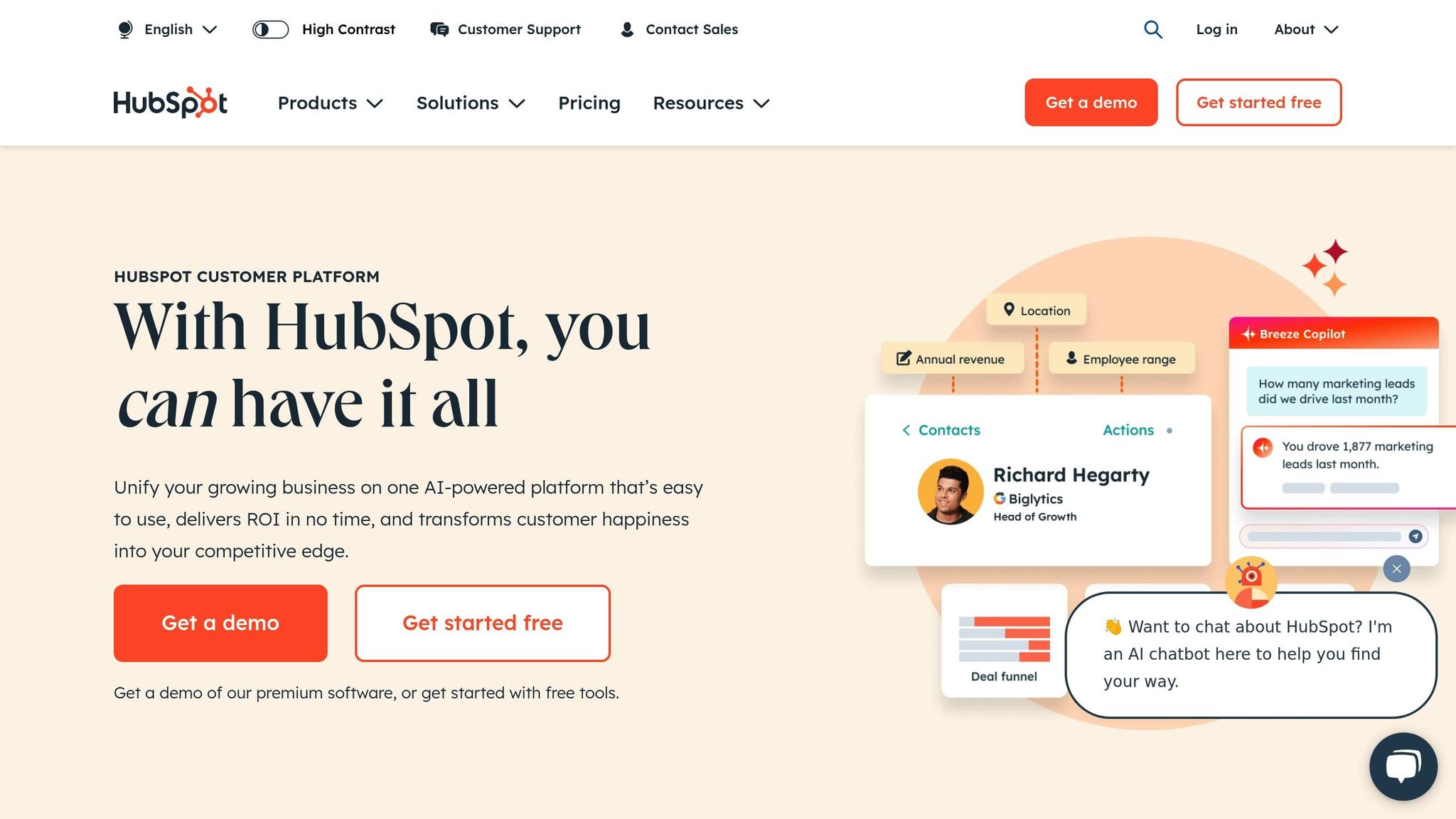Large Language Models (LLMs) are changing how people search online, and businesses like HubSpot are feeling the impact.
Key highlights:
- HubSpot’s organic traffic dropped from 13.5M visits in Nov 2024 to under 7M in Dec 2024.
- Google’s shift to AI-driven search results prioritizes direct answers over traditional "search-and-click" models.
- New AI-powered platforms like ChatGPT are gaining popularity, with usage jumping from 1% to 8% in 2024.
- HubSpot’s broad-topic SEO strategy struggled as Google now favors expertise in specific areas.
Why it matters: Businesses must adapt to AI-driven search trends by focusing on specialized, high-quality content and leveraging AI tools to stay competitive.
How LLMs Change Search Results
As search engines shift toward an answer-first approach, large language models (LLMs) are reshaping how information is delivered. This evolution has had a noticeable impact, with Google’s market share dropping from 80% to 74% as AI-powered alternatives grow in popularity [5].
What Are LLMs and How Do They Work
LLMs are advanced AI systems designed to understand and process natural language queries. Instead of relying on traditional keyword matching, they analyze the meaning behind queries to provide accurate, context-based answers. These models also extract structured data to deliver results quickly [4].
Key features of LLMs include:
- Natural language processing
- Extracting structured data
- Synthesizing information quickly
- Generating direct answers
This approach is driving a new, more efficient search experience.
Search Result Changes and User Experience
LLMs have significantly altered how users interact with search engines. Instead of clicking on multiple links, users now often get immediate answers [5]. This change is reflected in how search results are displayed and consumed.
"The links included in AI Overviews get more clicks than if the page had appeared in a traditional web listing for that query." – Liz Reid, Head of Google Search [5]
Here’s how platform usage has shifted:
| Search Platform | June 2024 | December 2024 | Change |
|---|---|---|---|
| 80% | 74% | -6% | |
| ChatGPT | 1% | 8% | +7% |
| Other Platforms | 19% | 18% | -1% |
Leading Companies in LLM Search
The rise of LLMs has pushed major tech companies to rethink their search strategies. Google’s Search Generative Experience (SGE) uses models like PaLM 2 and MUM to create AI snapshots at the top of search results. These snapshots focus on verifying facts and attributing sources [6].
Microsoft, on the other hand, has aggressively integrated AI into Bing, completely redesigning its search platform around LLM capabilities [6]. OpenAI’s ChatGPT has also emerged as a key player, now accounting for 8% of primary search usage [5].
"We want [the LLM], when it says something, to tell us as part of its goal: what are some sources to read more about that?" – Liz Reid, Google’s VP of Search [6]
Google’s approach is more measured, emphasizing accuracy. Its AI snapshots adapt to the context of a search query, often including visuals and maintaining a connection to the original sources [6]. The company is also exploring how to integrate advertising into these AI-driven results, which could reshape how search engines generate revenue [6].
HubSpot‘s Traffic Loss Analysis

HubSpot’s Past SEO Performance
HubSpot’s blog used to be a major driver of organic traffic, with its blog subdomain generating about 75% of the company’s total traffic. At its peak, the blog attracted around 13 million monthly visitors (Ahrefs data) or 18 million (Semrush data) [9]. The company relied on a strategy focused on high-volume, broad-topic content to dominate search rankings. This approach worked well in the era before search engines shifted to AI-driven models, where keyword matching and backlinks were key. This impressive past performance highlights the stark contrast with the traffic decline that followed.
Traffic Drop Data and Key Events
HubSpot’s organic traffic took a sharp dive between 2024 and early 2025, as shown in the table below:
| Time Period | Monthly Organic Traffic | Data Source |
|---|---|---|
| January 2024 | 14.8 million | Semrush |
| November 2024 | 13.5 million | Semrush |
| December 2024 | 8.6 million | Semrush |
| January 2025 | 2.8 million | Semrush |
This steep decline reflects how quickly search engine changes affected HubSpot. The number of keywords HubSpot ranked for in Google’s top 3 results plummeted from 138,000 to 30,000, a 78% drop [9]. Similarly, Sistrix‘s Visibility Index reported a 76% year-over-year decrease [9].
Main Reasons for Traffic Decline
Several factors contributed to this significant drop in HubSpot’s organic performance:
- Algorithm Update Effects: Google’s March 2024 core update reshaped how it identifies low-quality or unoriginal content. HubSpot’s search visibility dropped by 45% as a result of this update, which penalized content deemed unhelpful [7].
- Impact of AI-Powered Search: The integration of AI in search engines changed user behavior dramatically. SEER Interactive found that organic click-through rates fell by roughly 70% when AI Overviews appeared in search results [5]. This shift hit HubSpot’s informational content especially hard.
- Loss of Topical Authority: HubSpot’s strategy of covering a wide range of topics diluted its perceived expertise. Google’s updated algorithms now favor websites that showcase deep knowledge in specific areas, which left HubSpot at a disadvantage [8].
These trends align with Gartner’s forecast that traditional search engine use could drop by 25% by 2026, as more users turn to chatbot-like AI tools [5]. For HubSpot, these changes arrived earlier and had a more dramatic impact, serving as a cautionary tale for content-heavy websites.
sbb-itb-d9b3561
SEO Updates for LLM Search
Meeting E-E-A-T Standards
Creating detailed, specialized content that shows real expertise is key to meeting E-E-A-T standards. Trust is built by using data in meaningful ways. As Kristi Holt, CEO of Vibeonix, puts it:
"Data is king. Everyone’s collecting more data today than ever, but if you don’t know what that data means, then it means nothing. That’s where Wrench comes in. They help you make sense of your data, boosting its business impact. I think every industry is going to turn to AI to make the most of their data." [3]
This approach lays the groundwork for using AI tools to improve content performance.
Methods to Keep Search Rankings
To maintain strong search rankings, combine E-E-A-T principles with AI-driven tactics. Here are some strategies:
| Strategy | Implementation | Expected Outcome |
|---|---|---|
| Real-time Analysis | Use AI tools to track content performance | Instant insights for optimization |
| A/B Testing Automation | Test multiple content versions with AI | Data-backed content improvements |
| Persona Development | Build detailed audience behavior profiles | More targeted and engaging content |
| Data Integration | Merge data from various sources | Better personalization and insights |
What’s Next for Search and LLMs
Expected LLM Search Changes
The way we search and consume content is evolving, thanks to the rapid rise of large language models (LLMs). Between Q3 and Q4 of 2024, LLM referral traffic skyrocketed by 800% – a clear signal of their growing influence [3].
Specialized LLMs tailored to specific domains are now emerging. These models are becoming more precise and efficient, requiring less computational power while delivering better results [10]. Sarah Friar, CFO at OpenAI, highlights the pace of this progress:
"I think we are going to see a lot of motion next year around agents, and I think people are going to be surprised at how fast this technology comes at us" [10].
Another game-changer is the integration of multimodal capabilities, enabling LLMs to process not just text but also images, audio, and video [10][11]. This shift opens up fresh opportunities for content creators but also brings challenges in maintaining visibility. These advancements are reshaping not just how users search but also how businesses – especially in the B2B space – must adapt.
B2B Marketing with LLMs
LLMs are shaking up the B2B marketing world. The global LLM market is expected to hit $259.8 million by 2030, growing at an annual rate of 79.80% from 2023 [12]. This growth demands that businesses rethink their strategies.
Here’s a snapshot of how search trends are shifting:
| Search Aspect | Current State | Future Trend |
|---|---|---|
| Query Format | Traditional keywords | Conversational dialogue |
| Result Display | Link-based listings | AI-generated summaries |
| User Behavior | Platform-specific | Multi-platform search |
| Content Priority | Backlink authority | Relevance and accuracy |
These changes mean businesses need to adjust their SEO approach, as covered in the next section.
Planning for AI Search Success
To stay visible in this changing landscape, companies must rethink their strategies. Traditional SEO methods are losing their edge, with predictions suggesting that 10-15% of search queries will shift to generative AI by 2026 [14].
Kelly Ayres, Director of SEO at Jordan Digital Marketing, underscores the importance of staying agile:
"Long-term SEO success in the LLM era will depend on continuous learning, testing and iteration based on data-driven insights" [13].
Here are three key areas to focus on:
- Content Structure: Design content to answer conversational queries directly and clearly. Use schema markup and build knowledge bases to help LLMs interpret and reference your content [14].
- Platform Reach: Expand your presence across platforms like AI-powered Bing and TikTok Search. Don’t forget about optimizing for voice search and AI assistants [15].
- Data-Driven Adjustments: Keep an eye on how AI-generated results influence search intent and rankings. Track engagement with LLMs and ensure your content is included in AI training data to remain discoverable [5].
Conclusion
HubSpot’s traffic struggles and the evolution of SEO underscore how large language models (LLMs) are reshaping search and redefining digital marketing strategies. The challenges faced by HubSpot reflect a broader industry shift, as traditional SEO methods are increasingly replaced by AI-powered approaches.
To succeed in this changing environment, businesses must find the right balance between human expertise and AI-driven tools. This shift is impacting content creation, optimization, and how companies engage with their audiences.
Here are three key areas businesses should prioritize:
- Data Integration: Combine data from various sources to gain deeper insights into customer behavior.
- AI Segmentation: Use AI to create more precise audience segments for personalized engagement.
- Strategic Flexibility: Continuously refine strategies to align with the evolving capabilities of LLMs.



